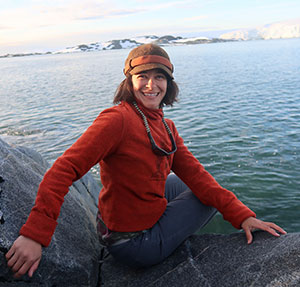
Dulcinea Groff, a University of Wyoming postdoctoral research associate, has been named the recipient of the William Skinner Cooper Award by the Ecological Society of America (ESA).
Groff will be recognized for her paper titled “Seabird Establishment During Regional Cooling Drove a Terrestrial Ecosystem Shift 5,000 Years Ago” that appeared in the Oct. 23, 2020, issue of Science Advances.
The Cooper Award, initiated in 1985, is given to honor an outstanding contributor to the fields of geobotany, physiographic ecology, plant succession or the distribution of plants along environmental gradients. These were all fields in which Cooper, a renowned ecologist, worked. The award is for a single contribution in a scientific publication, whether written by a single author or multiple authors.
“It is an honor and very exciting to be recognized for our work reconstructing seabird populations that inhabit coastal tussac grasslands of the Falkland Islands over millennial timescales,” says Groff, of Conway, Ark. “Receiving this award highlights that our work contributes to a broader understanding of the importance of plant-animal interactions and linkages across marine and terrestrial ecosystems.”
Groff will receive a plaque and is invited to attend an awards banquet at the annual ESA Conference in Montreal, Quebec, Canada, Aug. 14-19. She also will receive travel funding to help with attending the conference.
Seabird populations in the South Atlantic and Southern Ocean are facing direct and indirect impacts of climate change due to rising temperatures and ocean acidification. However, long-term monitoring of seabird populations in the South Atlantic and Southern Ocean typically only began in the 1950s, posing a challenge to understanding the long-term responses of seabirds to global change.
Groff led a study that put together a puzzle of the 14,000-year-old record of tussac grasslands in the Falkland Islands.
Seabirds first came to the Falklands approximately 5,000 years ago, just as the region was cooling, the study says. Seabirds there are situated by the parts of the tussac grass the birds use. For example, some seabirds use the soft peat beneath the tussac to burrow into and make their nests, Groff says. These include the Magellanic penguin, white-chinned petrel, thin-billed prion, common diving petrel, Falkland diving petrel, sooty shearwater and great shearwater.
There are ground-level nesting seabirds such as the Southern rockhopper penguin as well as seabirds that commonly nest adjacent to the tussac grass. These include the black-browed albatross, gentoo penguin, rock shag, South American tern, kelp gull and Imperial Cormorant.
Marine-derived nutrients from bird guano facilitated tussac establishment, the paper says. To compile the 14,000-year-old record, the research group collected peat profiles for pollen and charcoal analyses and reconstructed seabird populations of the past. The peat profiles allowed the research group to determine the order of events with the seabirds and their breeding habitat, the tussac grasslands.
At the time of the study, which took place on separate trips during 2014 and 2016, Groff was a Ph.D. student at the University of Maine. The work is a chapter of her dissertation.
“I think the paper was chosen for this particular award because we use multiple lines of evidence for the presence of seabirds, their response to climate and their impact on remote oceanic island ecosystems,” Groff says. “The arrival of seabirds and their nutrient-rich guano initiated a rapid ecosystem state shift that fueled the development of a tussac grassland and a new wildfire regime. The work has clear implications for both the conservation of seabirds in a warming world and demonstrates the importance of marine-derived nutrients to coastal grasslands.”
Groff adds her work is consistent with the interests and research themes of Cooper, who also began his career working on physiographic ecology of a remote island ecosystem -- on Isle Royale in Lake Superior.
Groff is still a UW postdoctoral research associate, but now splits her time between the Wyoming Established Program to Stimulate Competitive Research (EPSCoR) Microbial Ecology Collaborative and a new National Science Foundation (NSF) Collaborative Research Award that allows her to research mosses and penguins in Antarctica.
To view Groff’s NSF grant, go to www.nsf.gov/awardsearch/showAward?AWD_ID=2012247&HistoricalAwards=false.

